
Reginald Joseph Mitchell was a British aircraft designer who worked for the Southampton aviation company Supermarine from 1916 until 1936. He is best known for designing racing seaplanes such as the Supermarine S.6B, and for leading the team that designed the Supermarine Spitfire.

The Hawker Hurricane is a British single-seat fighter aircraft of the 1930s–40s which was designed and predominantly built by Hawker Aircraft Ltd. for service with the Royal Air Force (RAF). It was overshadowed in the public consciousness by the Supermarine Spitfire during the Battle of Britain in 1940, but the Hurricane inflicted 60% of the losses sustained by the Luftwaffe in the campaign, and fought in all the major theatres of the Second World War.

Battle of Britain is a 1969 British war film directed by Guy Hamilton, and produced by Harry Saltzman and S. Benjamin Fisz. The film documents the events of the Battle of Britain. The film drew many respected British actors to accept roles as key figures of the battle, including Laurence Olivier as Air Chief Marshal Sir Hugh Dowding, Trevor Howard as Air Vice-Marshal Keith Park, and Patrick Wymark as Air Vice-Marshal Trafford Leigh-Mallory. It also starred Michael Caine, Christopher Plummer, and Robert Shaw as Squadron Leaders. The script by James Kennaway and Wilfred Greatorex was based on the book The Narrow Margin by Derek Wood and Derek Dempster.

The Supermarine Attacker is a British single-seat naval jet fighter designed and produced by aircraft manufacturer Supermarine for the Royal Navy's Fleet Air Arm (FAA). The type has the distinction of being the first jet fighter to enter operational service with the FAA.
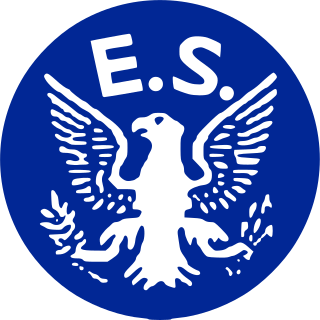
The Eagle Squadrons were three fighter squadrons of the Royal Air Force (RAF) formed with volunteer pilots from the United States during the early days of World War II, prior to America's entry into the war in December 1941.
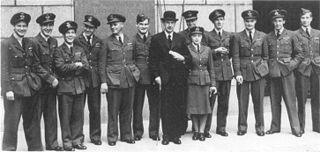
The Few were the airmen of the Royal Air Force (RAF) and the aviators of the Fleet Air Arm, Royal Navy (RN) who fought the Battle of Britain in the Second World War. The term comes from Winston Churchill's phrase "Never, in the field of human conflict, was so much owed by so many to so few." It also alludes to Shakespeare's famous speech in his play, Henry V: "We few, we happy few, we band of brothers..."

The Supermarine S.6B is a British racing seaplane developed by R.J. Mitchell for the Supermarine company to take part in the Schneider Trophy competition of 1931. The S.6B marked the culmination of Mitchell's quest to "perfect the design of the racing seaplane" and represented the cutting edge of aerodynamic technology for the era.

Wing Commander Brendan Eamonn Fergus Finucane,, known as Paddy Finucane amongst his colleagues, was an Irish Second World War Royal Air Force (RAF) fighter pilot and flying ace—defined as an aviator credited with five or more enemy aircraft destroyed in aerial combat.
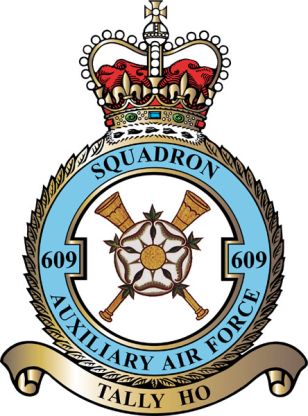
No. 609 Squadron of the Royal Auxiliary Air Force, originally formed as a bomber squadron and in the Second World War active as fighter squadron, nowadays provides personnel to augment and support the operations of the Royal Air Force. The squadron is no longer a flying squadron, but instead has the role of Force Protection. It is currently based at RAF Leeming, North Yorkshire.

Hucknall Aerodrome was a former general aviation and RAF aerodrome located 5 nmi north north-west of Nottingham, Nottinghamshire, England and west of Hucknall town. The aerodrome had been operated by the Merlin Flying Club since 1971 and then by Rolls-Royce Group plc. Before its closure, it was owned and operated by ITP Aero.

Duxford Aerodrome is located 8 nautical miles south of Cambridge, within the civil parish of Duxford, Cambridgeshire, England and nearly 1-mile (1.6 km) west of the village. The airfield is owned by the Imperial War Museum (IWM) and is the site of the Imperial War Museum Duxford and the American Air Museum.
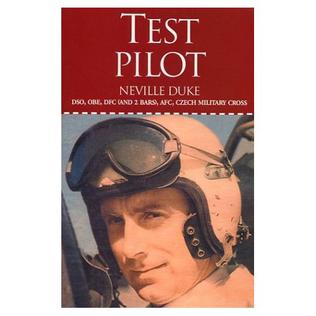
Neville Frederick Duke, was a British test pilot and fighter ace of the Second World War. He was credited with the destruction of 27 enemy aircraft. After the war, Duke was acknowledged as one of the world's foremost test pilots. In 1953, he became holder of the world air speed record when he flew a Hawker Hunter at 727.63 mph (1,171.01 km/h) over Littlehampton.

Angels One Five is a 1952 British war film directed by George More O'Ferrall and starring Jack Hawkins, Michael Denison, Dulcie Gray, John Gregson, Cyril Raymond and Veronica Hurst. Based on the book What Are Your Angels Now? by Pelham Groom, the plot centres on a young fighter pilot immediately before and during the Battle of Britain in the Second World War. Some scenes in the film were shot at RAF Uxbridge, where there was a wartime operations room.
Jeffrey Kindersley Quill, was a British test pilot who served on secondment with the Royal Air Force and Royal Naval Volunteer Reserve during the Second World War. He was also the second man to fly the Supermarine Spitfire after Vickers Aviation's chief test pilot, Joseph "Mutt" Summers. After succeeding Summers as Vickers' chief test pilot, Quill test-flew every mark of Spitfire. Quill's work on the aircraft aided its development from a promising but untried prototype to become, with the Hawker Hurricane, an instrument of the Royal Air Force's victory in the Battle of Britain. The Spitfire later played a leading role in gaining Allied air superiority over Europe. Quill later wrote two books about the Spitfire.

The Supermarine Spitfire, the only British fighter to be manufactured before, during and after the Second World War, was designed as a short-range fighter capable of defending Britain from bomber attack and achieved legendary status fulfilling this role during the Battle of Britain. According to fighter ace J.E. "Johnnie" Johnson it was the best conventional defensive fighter of the war.
Captain Joseph "Mutt" Summers, was chief test pilot at Vickers-Armstrongs and Supermarine.

The Rolls-Royce Griffon engine was designed in answer to Royal Navy specifications for an engine capable of generating good power at low altitudes. Concepts for adapting the Spitfire to take the new engine had begun as far back as October 1939; Joseph Smith felt that "The good big 'un will eventually beat the good little 'un." and Ernest Hives of Rolls-Royce thought that the Griffon would be "a second power string for the Spitfire". The first of the Griffon-engined Spitfires flew on 27 November 1941.

The Supermarine Spitfire is a British single-seat fighter aircraft used by the Royal Air Force and other Allied countries before, during, and after World War II. Many variants of the Spitfire were built, from the Mk 1 to the Rolls-Royce Griffon-engined Mk 24 using several wing configurations and guns. It was the only British fighter produced continuously throughout the war. The Spitfire remains popular among enthusiasts; around 70 remain airworthy, and many more are static exhibits in aviation museums throughout the world.
Squadron Leader Ernest Derek 'Dave' Glaser was a British Royal Air Force officer of the Battle of Britain, and later a notable test pilot.
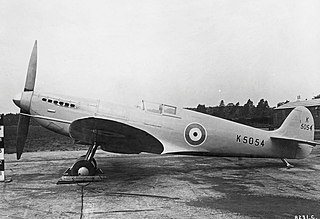
The Supermarine Spitfire was developed in the mid-1930s as a short-range, high-performance interceptor aircraft by chief designer R. J. Mitchell.

































